World Dream Bank
home -
add a dream -
newest -
art gallery -
sampler -
dreams by
title,
subject,
author,
date,
places,
names
OISIN
by Chris Wayan, 2006
dedicated to Poul Anderson for his remarkable world-building
Oisin homepage - Map - Rhiannon - Farside - Gazetteer - Terms explained - Nomenclature - More worlds? Planetocopia!
Oisin is a moon like Europa, with ice-covered seas. But Oisin's a bit warmer, and the ice is thinner. That small difference led to an explosion of life! Why? Let me begin with the planet this moon orbits...
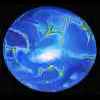
Lyr, my model of a huge wet biosphere, has six moons--a modest number for such a giant (7 earth masses!) Four are mere rocks under 1000 km across, but one is 2100 km (1300 mi) wide, as big as Pluto, and one's as big as Titan: 5000 km (3100 mi). It's a fascinating world in its own right--tectonically active, with a thin atmosphere. Let's call it Oisin ("o-SHEEN") after that legendary Celtic mariner--or perhaps it's a pun on "ocean." That'd be appropriate, for Oisin is all about oceans--both on Lyr and on Oisin itself.
Oisin orbits Lyr 300,000 miles out, further than Luna does, yet Oisin's so big its tidal pull is still over 50% stronger. Lyr is too massive for Oisin to have slowed its spin much, but the strong tides don't just affect Lyr's seas; the stress largely explains Lyr's hyperactive tectonics. Indeed, without Oisin, would Lyr have land thrusting above the waves at all? A big moon shapes its planet just as much as the reverse!
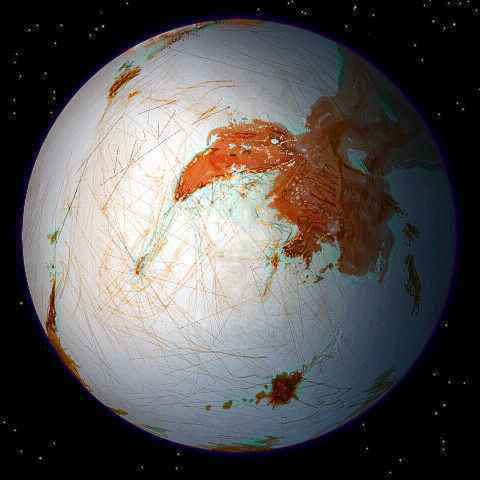
Just like Lyr, Oisin is massaged by strong tidal stresses. So it's quite active--volcanoes and rifts with hot, mineral-rich vents. Much like primal Earth, under its icy mask! Life on Oisin appeared early, maybe seeded from Lyr via meteor strikes, but possibly home-grown: all the ingredients were there, after all.
For eons, Oisin looked like just a bigger Europa: an ice-covered, shoreless sea, with "tectonic plates" of ice not rock, cracked, deformed and stained by briny eruptions. But looks are deceiving: Oisin gets more sun than Europa, and that has three effects.
- The seas are warmer beneath. Oisin's ice skin thins out to as little as a meter thick in the tropics, letting light into the sea below. Instead of being limited to chemical energy around hot springs, Oisin's life has an outside energy source--photosynthesis. Algae grows on the underside of the ice all over Oisin, and plankton evolved to eat it, and "fish" to eat the eaters... There's a full, fascinating life-web rather like the rich seas off Antarctica, but five times larger--Oisin's ice sea covers 64 million square km (25 M sq mi, nearly the size of the Indian Ocean.)
- In Oisin's tropics, the ice skin slowly sublimes (evaporates without melting). Most of the vapor eventually redeposits as glaciers on the polar continents of Maeve, Cernunnos and Don. Oisin's gravity is low so the ice creeps very slowly, but eventually it re-enters the sea as meltwater--or as part of the ice-skin. Slow-motion currents! The ice-skin deforms and creeps imperceptibly from the poles toward the tropics, causing most of the cracking you see. (Not quite all of it--the continents move, too! Oisin, unlike our moon, is tectonically busy--and inches a year add up. But most of what you see is iceflow.) Life flourishes in the brighter sunlight of these cracks, though life there is precarious (the cracks are prone to ruptures that fountain into freezing near-vacuum). The iceflow spreads life, too--even algae clinging to the ice migrate over generations.
- Tropical sublimation has a long-term effect. Most of the vapor redeposits, but the dim red sun's radiation manages to crack a few water molecules; the lighter hydrogen escapes Oisin's weak gravity (0.3 G) forever. Traces of oxygen remain in the atmosphere, forming an ozone layer, and recombining with some of the fleeing hydrogen. Feathery ice clouds drift in the thin nitrogen atmosphere (still thicker than Mars's). In the current geological era, there's solid land at both poles, so ice crystals precipitating there can build up into true polar ice caps. These slowly steal water from the seas too.
The result? Ruddy rock continents are slowly emerging, visible from Lyr... an underlying Martian skull, breaking through that sleek Europan skin!
But in most places the sea's still several km deep. The long ebb has been slow, and even if only a fraction of the primal sea survives, it started out deep--maybe as much as 50 km (30 miles). Oisin is doomed to become a cold Martian desert in the long run--the very long run. But it's nicer than Europa while it lasts! Why? This slow, endless ebb-tide actually enriches life on Oisin. The ancient sea offered three environments:
- the underside of the ice, basking in light but poor in minerals
- the black sea-bottom, rich in minerals but energy-poor except around vents
- the ocean between, poor in everything.
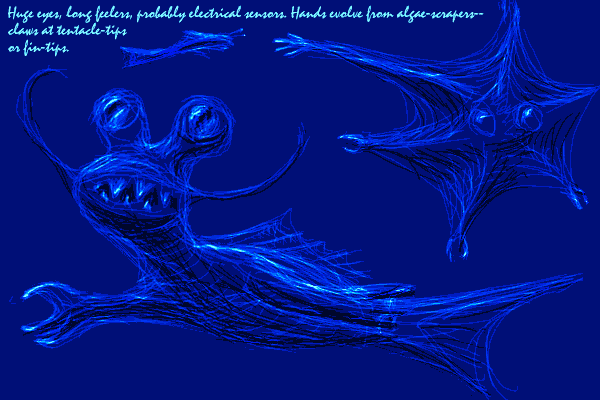 That was more diverse (and friendlier) than Europa, whose ice, (as I write this) seems so thick that biozone 1 is missing and all life's in the dark... but still, primal Oisin was hardly ideal. But on Oisin today, as land slowly rises from the ebbing sea, there's a fourth zone:
That was more diverse (and friendlier) than Europa, whose ice, (as I write this) seems so thick that biozone 1 is missing and all life's in the dark... but still, primal Oisin was hardly ideal. But on Oisin today, as land slowly rises from the ebbing sea, there's a fourth zone:
- continental shallows and ice-bound lakes. Sun, water and minerals come together. Algae, plankton, "krill", "crabs"... fish? Giant squid? Sea-dragons? Life flourishes in grotesque gardens as rich as Earth's coral reefs. Ice Paradise!
Wait--let's be thorough. Actually, the land creates a fifth biozone, too:
- life underground on land--sparse and mostly microbial. This zone is more like what Mars may hide. Yet it's the least developed and interesting of Oisin's communities--for energy is just too limited.
ON THE ICE
Imagine you're standing on the ice in Govannon Bay. It's high summer. The little copper penny of the sun casts a warm but dim light; your instincts read it as indoor light. Oisin as a monster ice-skating rink! A few faint cirrus feathers mark the violet sky. The craggy red Finn Mountains rise to the north. Lyr looms over your shoulder, visibly flattened, like a blue-white paisley blimp.
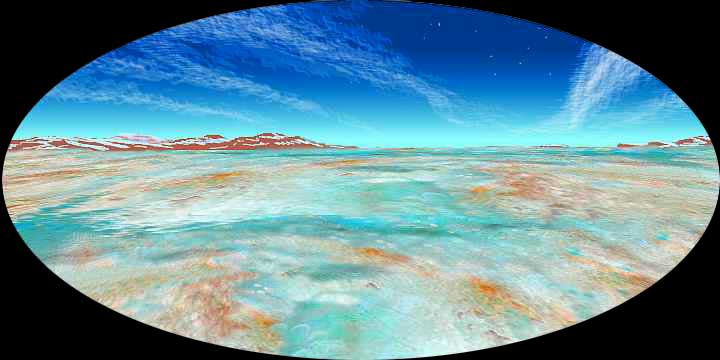
If you don't have a pressure suit, you're collapsing right now. The air's just too thin--four times that of Mars, but only a thirtieth of Earth at sea level. On the other hand, you don't need a massive space suit with air tanks, just a tight suit and a helmet with a small air-compressor; Oisin's air is thin but does contain oxygen. The cold, the ozone, the radiation? Tolerable, short-term. The air is well below freezing, but no worse than many Earth winters. It's just that the spring thaw never comes!
Find a clear spot and peek down through the blue ice. You may see eyes looking back at you. Sea monsters, peering through a hazy ice window at deep space, like goldfish in a bowl!
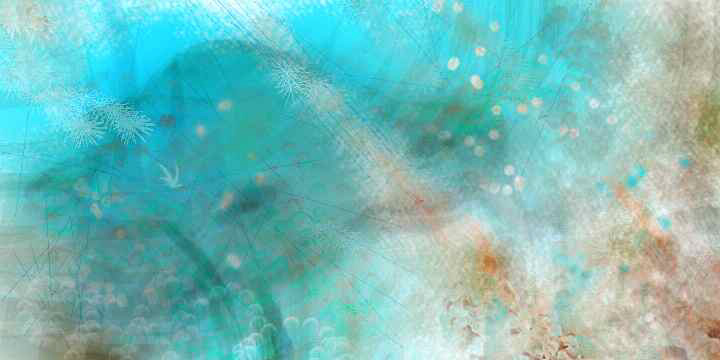
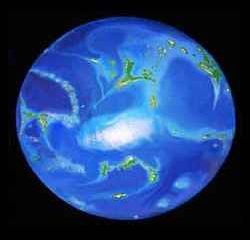
Do they worship Lyr, that huge blue fish in the violet sky-sea? Well, only on the near side, in the shallows around the great continent of Rhiannon and its fleet of islands. On Farside, they'll inevitably be sunworshipers unaware they're not living on a planet, but a mere moon! In the reefs round Dagda, Edain and the Brigid Isles, Lyr's little gold sun is the flaming dragon-eye of God.
Do I really think such a sealed, changeless womb could ever engender intelligence? Maybe you're skeptical--cetaceans are air-breathers, after all. But octopi and squid aren't stupid. It's true that opportunities for high technology look limited in a metal-poor, ice-bound sea; but our sea monsters will have a very long time to develop their culture in other directions. Oisin's sun is small and cool; its low fires will last billions of years, far longer than our sun.
So it's hasty to assume that little Oisin, in its seven billion years of history to date, won't have developed minds worth listening to.
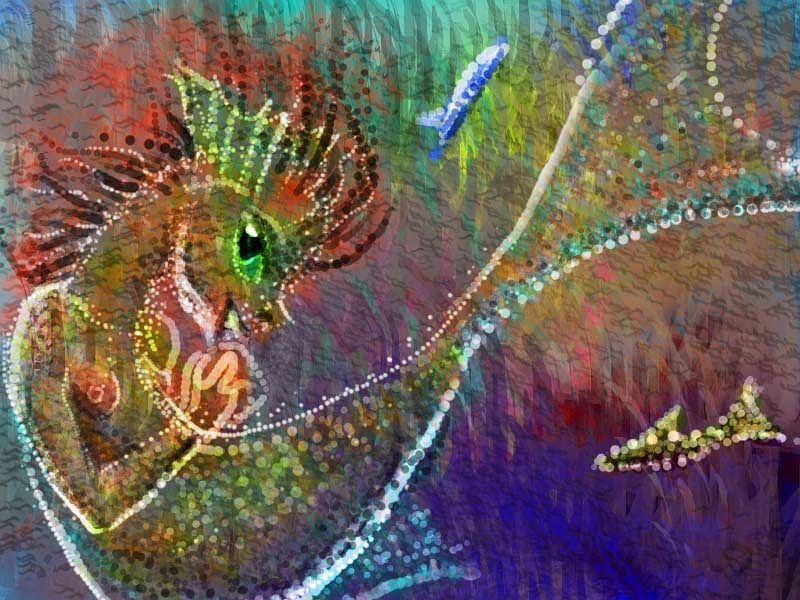
And if not? Or if they're intelligent enough but not to your taste? Sneaky, impulsive, plodding, thuggish, parochial, know-it-all? Just wait and check back in a hundred million years--or after the next comet strike. Oisin's a long-haul moon. You never know what's growing in the back of your fridge.
OISIN: BASICS
-
Orbit = 500,000 km out from its primary. Interestingly, its inclination is nearly zero. Since Oisin's in the plane of Lyr's orbit, eclipses are regular. The Lyr-facing side of Oisin sees a solar eclipse every noon--for over an hour, Lyr turns into a flaming red ring in the suddenly midnight sky; and every new moon, Lyr has a total solar eclipse, with a path of totality much wider than on Earth.
-
Total annual insolation = about 25% of Earth's (Mars gets about 44%, Europa only 4%, Titan 1%). Tidal stresses from Lyr and the sun keep Oisin's ocean thawed, with an ice skin much thinner than Europa's. How thin can ice get and still protect the sea beneath from boiling off into near-vacuum? Turns out it only takes a meter or two! (Confession: I deliberately gave Oisin much more sun than Europa, pushing it close to this boil-off limit... out of laziness. I wanted to create two worlds at once, so I made Oisin a moon orbiting Lyr, a world which needed more sun than Jupiter or the outer asteroid belts to support life. So I put my pair right where their respective life-zones meet. Both are near the edges! Any warmer, and Oisin would die; any colder, Lyr would... well, not die, but it'd become a cold dreary place, and I wanted a tropical vacation. If I wasn't dumber than an amoeba I'd just grant this odd couple a divorce--Lyr could orbit closer in, and Oisin could circle another gas giant further out, or even be promoted to a small planet. My point? If you calculate that Oisin needs less sun than I describe, or Lyr needs more, don't let that convince you their TYPES aren't viable! They represent two SEPARATE unearthly scenarios for life in SEPARATE orbits, really. Thus, they TRIPLE, not double, the number of potential lifezones out there.
-
Axial tilt = only 2 degrees. Instead of hemispheric seasons as on Earth, Oisin has orbital seasons--when Oisin and Lyr are furthest from the sun, insolation drops to 2/3 summer levels, worldwide.
-
Year = around 2.5 Earth years. I'm being vague because I haven't looked up the curve for light vs mass of Oisin's sun yet, and the mass determines the year-length. Just wanted some wiggle room! I warned you I was lazy.
-
Mass = 0.04 Earths. That's 3.2 Lunas, or one-third of Mars.
-
Density = 4.17 gm/ml. Denser than Titan, lighter than Earth--like Mars. It's why Oisin's held onto its atmosphere at all. Oisin clearly has a fair-sized iron core, though the outer layers are rich in lighter rocks and ices.
-
Diameter = 5000 km (3100 miles), similar to Mercury and Titan. Circumference is 15,700 km (9750 mi); a degree is 44 km (27 mi). The lines on the map are 1300 km (800 mi) apart.
-
Surface area = 77 million sq km (30.2 M sq mi): the size of the Atlantic. See map.
-
Gravity = .30 G. Enough to hold a tenuous atmosphere.
-
Surface radiation and UV levels = Earthlike, despite the thin atmosphere. We're further from the sun, it's a cool red star producing much less to start with, and what air there is is rich in ozone.
-
Day = 5.3 Earth days Oisin keeps one face to Lyr, like Luna, but orbits much faster since Lyr is so much heavier than Earth.
-
Nights = Lyr looms over the nearside, a blue-white oval nearly seven times the apparent width of our moon, taking up over 40 times as much sky. Though the orange sun is dimmer than Sol, Lyr's clouds reflect far more light than Luna's dull rocks. Lyrlight, at full, is over 60 full moons! Bright enough to see color at midnight, bright enough to penetrate the ice. On Oisin, coral reefs grow by moonlight.
-
Sea = 83% of surface area. 64 million sq km (25 M sq mi), nearly as big as the Indian Ocean. See map.
-
Land = 17% of surface, or 13 M sq km (5.13 million square miles--bigger than Europe, smaller than South America)
-
Tectonic activity = significant. Tidal stress is high, not just from Lyr itself but the sun and the neighboring moon Manannan. The heat creates surprisingly Earthlike deepsea vents, rifts, plates and trenches under the seas. There's occasional vulcanism, though at present all vents on land are dormant.
-
Relief = high. Not surprising, in this low gravity. Oisin's moving plates push up several Andes-like ranges at plate boundaries. Most ranges are undersea of course, but the highest peaks rise 10 km above the sea ice (Earth: 8.8; Lyr, 5.1); the deepest ocean trench is 40 km (Earth, 11; Lyr, 19).

-
Atmosphere = mostly nitrogen, oxygen, water vapor, neon, ozone, and C02--only traces of the last, since the seas absorb what's vented along the abyssal rifts. That keeps the air temperature low enough so the ice-skin protects the sea that shelters the life that... It's almost enough to make you believe in the Gaia Hypothesis! (Oisin Hypothesis?) Or... Intelligent Design. And you'd almost be right--but since the designer is me, we'd better say Stupid Design.
-
Air pressure at sea level = 25 millibars in summer, up to 30 in winter cold snaps--over four times the average on Mars, but only twice the air at the bottom of Hellas Basin. It's only a thirtieth of Earth's surface pressure, but that's enough so liquid water can survive... a few minutes. If there were any. It's too cold.
-
Air temperature = Strong daily cycles--in high summer, from -20 to -80 C, in winter -60 to -120 C. A few meters beneath, it's 0 degrees of course; barely thawed seawater. In summer heatwaves, air temperature may soar near zero; the ice surface "sweats" and smooths out, turning the ice from white to clear, increasing light penetration and improving the view... and generating ice clouds.
-
Sky color = deep purple around the horizon, though the zenith's usually black. At high noon in summer, sublimation from the ice creates faint haze and even clouds; the zenith purples and the horizon turns almost blue.
-
Cloud cover = sparse. A few cirrus clouds (ice crystals) in summer, and in high noon at the equator in summer, occasional thin fogs of sublimating vapor.
-
Albedo (reflectivity) = high. Where brine leaks full of algae and salts haven't stained the surface, 75-80% of visible light is reflected. No wonder the sea stays frozen. Both ice and water are climatically "sticky." Each state perpetuates itself: dark water absorbing heat, ice reflecting it. 600 million years ago, Snowball Earth was much like Oisin despite 3-4 times the insolation. Blame albedo!
-
Age = 7 billion Earth years.
-
Total biomass = 4% of Earth's
- Land = near 0%. Only subsurface bacteria survive on the harsh, Martian continents.
- Sea = around 35% of Earth's average planktonic density, but shallows and vent communities are as rich as similar Earth habitats.
-
Habitat diversity = low. Only five zones: shallows (photosynthetic, rich), sea-bottom vent communities (rich but chemical-based), the underside of sea ice (photosynthetic but mineral-poor, varying in density), deep-sea waters (scavenging, quite thin), and underground (the only land-life; sparse and mostly bacterial)
-
Intelligent species = who knows?
AFTERTHOUGHT
Oisin illustrates something hard to see when you only look at its big, rich primary, Lyr. Swathed in dense heat-trapping air, Lyr looks as if it orbits in the Goldilocks Zone, where the sun's juuuust right--just warm enough for liquid water. Many planetologists say that's the only place we'll find life. But Lyr's deceptive--Oisin's the naked truth. Without its dense atmosphere, Lyr would be like Oisin--colder than Mars! The two worlds get little more warmth from their sun than our asteroids do. Indeed, a little more sun would've killed Oisin. Its thin ice skin would have melted and its seas evaporated long ago. An ice-sea moon can survive closer to the sun than Europa--but not, by definition, in the Goldilocks zone. Oisin's on the edge--and that's what makes it fascinating. Such a thin, transparent skin creates an aquarium full of light and life.
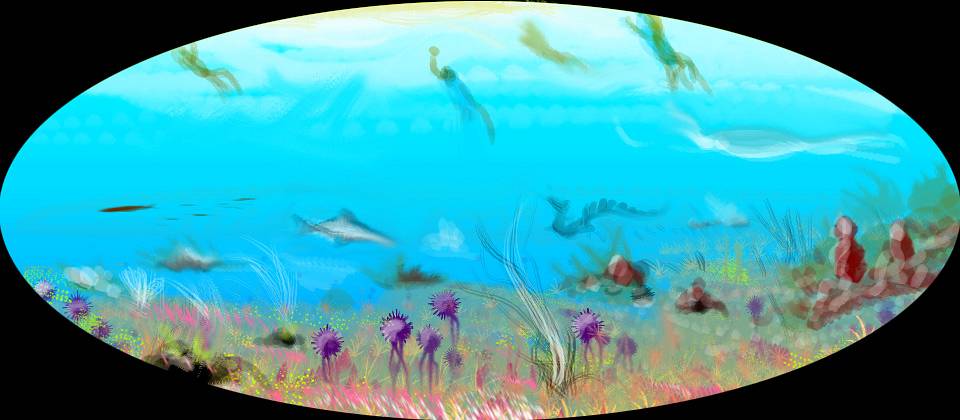 My point? The very idea of the Goldilocks Zone is, well, a fairytale. An orbit CAN be too close, too hot to allow life. But too far, too cold? Lyr and Oisin demonstrate two different ways a world can be well outside the Goldilocks Zone and still bear life. Really there are overlapping life-zones, one for each type of world. Hence, life will be more common than we think.
My point? The very idea of the Goldilocks Zone is, well, a fairytale. An orbit CAN be too close, too hot to allow life. But too far, too cold? Lyr and Oisin demonstrate two different ways a world can be well outside the Goldilocks Zone and still bear life. Really there are overlapping life-zones, one for each type of world. Hence, life will be more common than we think.
Who'd have ever guessed cold could be a virtue? The right amount, of course. Oisin is on the edge--the hot inner edge of the Europan life-zone. And that edge, not the center, is optimum for this sort of life--the thinnest ice, the most light. There's something to be said for marginality!
Oisin, doomed Oisin, is nearly the climax of its type.
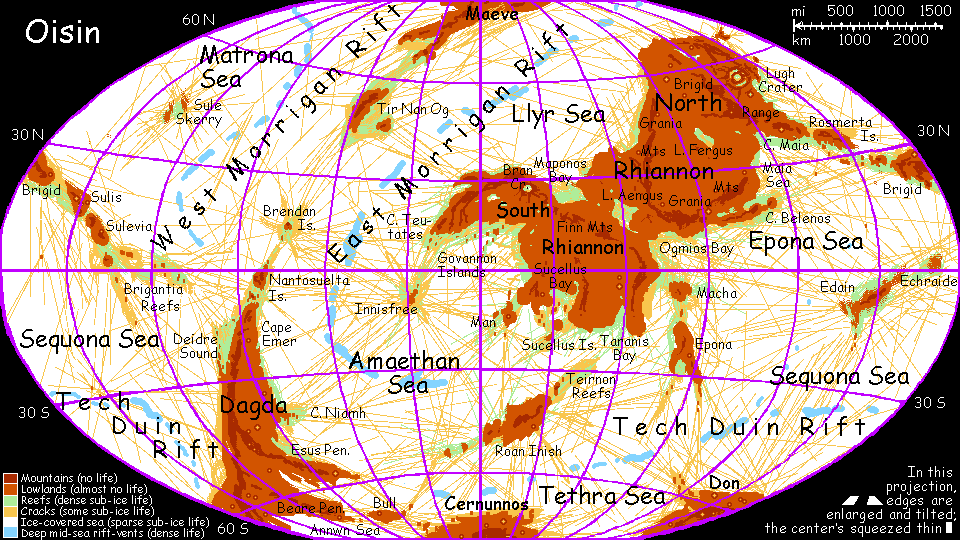 Oisin homepage - Map - Rhiannon - Farside - Gazetteer - Terms explained - Nomenclature - More worlds? Planetocopia!
Oisin homepage - Map - Rhiannon - Farside - Gazetteer - Terms explained - Nomenclature - More worlds? Planetocopia!
World Dream Bank homepage - Art gallery - New stuff - Introductory sampler, best dreams, best art - On dreamwork - Books
Indexes: Subject - Author - Date - Names - Places - Art media/styles
Titles: A - B - C - D - E - F - G - H - IJ - KL - M - NO - PQ - R - Sa-Sk - Sl-Sz - T - UV - WXYZ
Email: wdreamb@yahoo.com - Catalog of art, books, CDs - Behind the Curtain: FAQs, bio, site map - Kindred sites